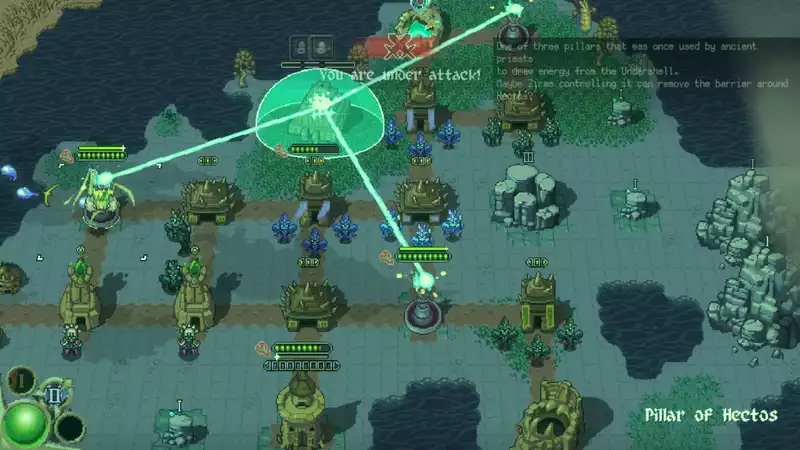Smelter begins with the story of Adam and Eve and the destruction of Eden, and ends with a race to free the Empress from her crystal prison and stop a giant evil demon from taking control of what appears to be a corner of Hell. The side-scrolling action platformer weaves together several indie genres, including a real-time strategy overland map, tower defense strategy, and top-down shooter. [Adam and Eve fall from paradise and are transported to a world of mailbox monsters, hidden laboratories, fallen empires, and flying masks named Smelter. He offers to merge with Eve, who has lost her place, Venom-style. Eve wants to find Adam, but Smelter wants to reclaim the lost empire of "Zilm," who for some reason resembles a dark elf. Their transformation is aided by an armored symbiosis that Eve calls "flotipoo," which accentuates her bulging lower tits and six-pack abs. The result is more battle bikini than super suit, but it comes with lots of fun attacks and abilities, including electro whips, blasters, and reflector shields.
To unlock and upgrade these abilities, you must conquer "rambly-land" (a cheeky term Smelter uses to describe the land map, which looks like a triangular star). This chatty symbiote was not kidding when he said he wanted to revive the empire. While Eve lounges by the pool, the storyline completely irrelevant until the end, I control Smelter as he flies around the map, constructing buildings, hiring zirums, and repelling enemy attacks.
The real-time strategy gameplay is not exactly Starcraft. It is a bare-bones RTS with no direct unit management, no technology tree, and no automated resource management. There are four main buildings and a fifth that can be unlocked later. The Orcharion shrine produces food (suspiciously, apples) and the houses use food to make zirum. The other two are defensive buildings, which automatically repel nearby enemies using melee attacks and bow and arrow zirums. The only choice is where to place the buildings, but it doesn't make much difference if you are smart enough to place the houses and shrines behind the barracks and outposts.
I gradually expand my empire into three regions, which are further organized into three linear areas away from my central base. In each area, I would need to accomplish objectives such as defending against enemy waves while powering up my cannons, defending against enemy waves while occupying stone monoliths, and eventually defending against enemy waves while doing the exact same thing.
The tower defense strategy provides a nice break between meaty platforming levels, but the limited buildings and repeated objectives stopped the fun after the first few hours. Since you cannot directly control your own units, there is little strategy beyond building more buildings, producing more units, repairing buildings, flying around, and shooting enemies with the same basic pew pew attacks.
Surviving the repeated tower defense challenges in each area allows you to jump into that area's level, transforming a simplistic tower defense RTS into a polished 2D action platformer.
The side-scrolling levels are just as fun and interesting as the RTS sections. Thanks to the varied level design and a deep skill tree that Eve can switch between to fully explore each area. Dashing behind enemies, clinging to walls, and jumping down to unleash waves of rock are satisfying in every level, and Smelter unlocks many of the best abilities, such as double jumping and wall jumping, almost immediately.
Each region also feels unique, with its own enemies, soundtrack, color palette, and storyline. On some levels, giant sandworms fill the screen. In the rainy jungle, you must avoid a rising tide of acidic water in a maze of corridors. The technology-themed region features walls of electricity and lightning-flying cloud dragons, which electrify rivers.
To survive these dangers, Eve can unlock three skill trees for each of the three regions and cycle through them with the press of a button. Each mode changes Eve's attack and grants her different traversing abilities. The first set includes a critical double jump, as well as a hard-hitting claw attack and a reflective shield; the second is a mid-range electro-whip with damage multiplier and dash jump; and the last unlocks a Mega Man-like blaster and the ability to glide softly.
The traverse ability adds to the fun and challenge of exploring all the false walls and hidden areas, looking for apple cores and trials hidden in each level. Apple cores upgrade buildings in strategic layers, and trials earn coins and upgrade skills.
Trials are short platform challenges with a single goal, such as not getting hit or found, and may feature a gauntlet of spikes, enemies, rotating platforms, sentry turrets, and laser walls. It's like replacing "Super Meat Boy" with a bizarre "Tron"-like simulation. Trials rarely take more than a minute to complete, but some are so challenging that they must be retried dozens of times. On the other hand, I found that the trials clearly improved my platforming skills against a variety of enemies and hazards. The trials' coins can be used to unlock better skills, such as upgrading your Mega Man-style blaster to use ricochets that bounce off walls, which is a great motivator to find and complete trials.
Smelter is not afraid to get very tricky in the final stages, with bosses and level sequences that require precise timing and memorization. The final dungeon is a checklist of the most frustrating elements one can experience in a platformer, including time-limited chases, instant death traps, and bosses with multiple forms. Modern checkpoints, including one at the start of each boss fight, prevented me from going completely bonkers during the extreme challenges of the final stages of the game.
Smelter tried and failed to layer an engaging RTS on top of a 2D action platformer. Thankfully, the majority of the film is spent on fun side-scrolling levels, searching for secrets, completing trials, and unlocking new abilities.
.

Comments